And so much more.
I went whale watching yesterday. At least that was the excuse I used to make the two-hour drive to Point Reyes National Seashore. The motivation to get out there by 9:30 AM was provided by the Sacramento Paddle Pushers, a Meetup.com group that had suggested the trip. (I’d gone on a 9-mile paddling trip with the SPP a few weeks before; they’re really active and do a lot more than paddling. Thought I’d blogged about it, but I guess not!)
I didn’t carpool with the group. Although I like the idea of carpooling — saving gas, companionship for a drive, etc. — I don’t like the idea of being tied to another person who I may or may not know very well. I like the freedom to make things up as I go along. And I absolutely detest waiting for other people to get organized or to give the green light for setting out on the next part of a drive. So I didn’t carpool. I drove out on my own, with Penny beside me and Google providing turn-by-turn driving instructions.
It was dark when I left at 6:30 AM. I not only wanted to get there on time, but I wanted the freedom to stop wherever I wanted to along the way. I headed westbound on I-80 as it got lighter and lighter and foggier and foggier. By the time I’d exited at Route 37, the fog was thick — so thick that I had to slow down going through the San Pablo Bay National Wildlife Refuge. Then it lifted just enough to make normal speed possible and I continued on my way.
The route Google chose took me through some residential areas before sending me toward the coast on Novado Boulevard. There were cows grazing on lush green hills along the way. The road wound up and down and around, past small lakes as wisps of fog got caught up in trees and floated on lake surfaces. The early morning sun shined brightly above the marine layer, trying so hard to break through. I stopped at Stafford Lake Park to let Penny take a walk while I shot a few photos.

The scene at Stafford Lake Park yesterday morning.

Not sure how I wound up with a veggie breakfast, but it was good. It’s always nice to try something different.
Eventually, we wound up at Point Reyes Station. It was early — only 8:30 AM. I had a whole hour to go the last 16 miles, which Google said would take me 33 minutes. I decided to stop for breakfast. I wound up at the Station House Cafe, which was pretty much empty. (Heck, the whole town was empty at 8:30; it would be very different later on.) I sat at the counter and although my brain really wanted an omelet as good as the one I’d had in Winters the morning before, I went with something completely different: cheese grits and sauteed Swiss chard. As I told a Facebook friend later in the day, it was good, but bacon would have made it better.
Please don’t lecture me about leaving my dog in the car. First of all, I only do this when I’m certain that the temperature in the car won’t exceed a balmy 70° or 80°F or get below 40°F. On warm days, I always park in the shade if possible. And if I’m parked in town, I always leave the doors unlocked so anyone could simply open them up if there was a concern.
Penny has spent a lot of time in the car — whether it’s my Honda, Jeep, truck, or a rental car — and is quite accustomed to it. She usually just settles down and goes to sleep.
On that particular day, the high in the area was forecasted as 50°F and although there was no shade, I did leave both front windows down a good 4 inches. I locked the doors, but anyone with a long, skinny arm could have unlocked them.
I was back in the truck, finishing up my drive by 9:00 AM. The road wound through the tiny town of Inverness on Tomales Bay before cutting west across the peninsula into the park. I followed the signs and wound up in the nearly empty Drakes Beach parking lot. I took Penny out for another quick walk and moved the truck to a spot closer to the ranger station. Then I gathered my camera equipment together, made sure Penny was set with food and water, locked up the car, and went to find the others.
I brought all my good camera equipment with me that day: my Nikon D7000 and 3 lenses, including my 300 mm lens, which I thought might be good to capture images of the whales. I also had my Manfrotto monopod. Yes, I know a tripod would be better, but I detest using one in situations involving moving subject matter. My monopod gives me enough steadying on full-sun shoots.
And there was plenty of sun that day. The fog was mostly burned off, although there was a definite white haze in the air. I went to the building just as the ranger was unlocking it. There were a handful of people milling about, but no one I recognized. I didn’t think it worth querying people to see if they were with the group. Again, I was leery of tying myself to one or more people until I knew how the day would unfold.
Like most other people there, I paid $5 for a shuttle bus ticket. Then I went outside and followed the group to a nice charter coach that was being used to shuttle park visitors to two points of interest: the Point Reyes Lighthouse and a spot called Chimney Rock. The bus pulled away from the curb and the driver, a big man who obviously had a lot of passion about the park and his job, told us a little about the wildlife we were already seeing: black-tailed deer and Tule elk. He then put in a short CD that explained a little of the park’s history and told us about the dairy farms we were passing along the way.
We were making the final climb up the road toward the lighthouse, when the man in front of me and I saw the same thing out on the ocean to our left: a whale! We’d already made our first spotting.
At the bus stop, we all got out and headed up the hill toward the lighthouse. There were about 20 of us in this first trip of the day. I took my time, taking in the view of the surf on the beach stretching out to the north. This was my third trip to Point Reyes and this particular view has become iconic for me. No matter when I come — late afternoon, midday, or morning — the pounding surf seems to disappear into the far distance, perfectly illustrating one of the themes I like to capture in my photography: infinity.

It looks like this pattern of waves against the shore could go on forever, no?
I caught sight of movement over a small hill and moved farther up the trail to investigate. On the other side of a clump of trees, on the hillside sloping down to the cliffs, were two black-tailed deer, grazing. I moved in among the trees for some photos while other bus passengers hurried by behind me, talking at full volume about anything other than their surroundings, oblivious to nature around them. Finally, someone spotted me with my camera and took a closer look. By the time I was finished, a small crowd had gathered with people snapping photos of the deer less than 100 feet away. To their credit, no one tried to approach them more closely.

Shot with a 300 mm focal length lens, cropping this photo was not necessary; this deer was close.
I reached the top of the steps leading down to the lighthouse and stopped for a moment to take in the view. We were on a point of land facing due west with sweeping views to the south and northwest. There wasn’t a cloud in the sky. The blue of the sky and the blue of the ocean met in a somewhat blurred line out in the distance. The sound of the waves and calling birds laid a background soundtrack to the chatter of the people around me. There was almost no wind at all. An absolutely perfect day to be at Point Reyes.

Google’s Map view of Point Reyes. The lighthouse is on the left (west) point; Chimney Rock is on the right (east) point.
There were 300 steps down to the lighthouse. A sign at the top of the steps warned that the climb back up was the equivalent of climbing a 30-story building. (I seriously doubt that. The stairs were shallow and easy. Maybe 20 stories.)
This is an interesting illustration of the way various lens focal lengths affect the appearance of distances. The top image was shot from the top of the stairs at 70mm. The bottom image was shot about halfway down the stairs (on my way back up) at 10mm. Neither image was cropped; both are shown here at the same size. Doesn’t the stairway look longer in the second image?

Once at the lighthouse, I joined a few other people there who were actively looking for whales. We were rewarded many times. A pair of young whales, maybe 20-25 feet long, were making their way around the point. They’d surface together every 5 or 10 minutes quite close to us, send up two sprays of misty air, give us a good look at their backs, and then disappear under the waves. They did this at least a half-dozen times while I watched with the others. Good photos weren’t possible — there just wasn’t any exciting activity. These whales were motoring, not auditioning for SeaWorld. This is the best I could do.

Yes, there are two gray whales in this photo. No NatGeo photo op yesterday.

An example of symmetry — or as much as possible, considering the light and rust patterns.
Since I wasn’t getting any satisfying whale photos, I started looking at other things that were interesting. The lighthouse, flowers along the stairway, equipment in the lighthouse building. Other themes and techniques I like to explore in my photography include symmetry, patterns, filling the frame with an image, and putting foreground items against out-of-focus backgrounds.

I don’t know why I like this photo so much, but I do. It seems to me that anyone can take a picture. But when a picture evokes an emotion — as this one does for me — it’s something worth looking at.


Two examples of an interesting foreground — irises in bloom — against an out-of-focus background. Which do you think works better?

I’m not sure, but I think this one is called red maid.

And I’m pretty sure this is a violet.

I’m pretty sure this is Indian Paintbrush.

Yellow bush lupine grows in huge clumps out on the peninsula.
One of the huge benefits of traveling alone is that you can spend your day the way you want to do it. No one to compromise with. No one to get bored and hurry you along. No one to drag you places you couldn’t care less about.
That was me yesterday. Spending as much time as I liked, seeing what I wanted to see. I know a companion would have lost patience with the amount of time I spent kneeling or even lying in the dirt to frame up some of these photos. I’ve had traveling companions like that in the past and I can’t begin to imagine the things I missed because of them.
(You could also argue that traveling companions can reveal a whole new world for you. I think that’s possible — with someone who is imaginative, open to seeing new things, and not opposed to changing plans as opportunities arise. But I haven’t had a companion like that for many, many years. Instead, I spent a lot of time stuck with someone who was tied to a schedule. Any suggested change resulted in, “But I thought we were going to….” I’d rather travel alone than deal with that ever again.)
Once I’d finished up at the lighthouse and made the climb up the 300 steps, I walked back to the bus stop. Along the way I peeked through the row of trees to see if the deer were still there. They were. And that’s when I noticed a third deer lying in the shade of a bush.

Can you see the deer in the background?
While I was enjoying my day, taking lots of photos, and really having a great time being outdoors in such a beautiful place, I was also chatting with the folks around me. One by one I met up with about a dozen of the SPP members, including Lynn, who’d organized the meetup. The group had broken into smaller subgroups of twos and fours, each wandering around the park at their own pace. Nice. No pressure.
I rode the bus to the Chimney Rock stop. There were three points of interest there: the elephant seal beach, the historic life boat station, and Chimney Rock point. The elephant seals were closest, so I took that path, getting into a conversation along the way with a woman from Las Vegas who was also traveling alone — and enjoying every minute of it. She and I would cross paths a few more times before the end of the day.
At the end of the path was a lookout point where we could clearly see hundreds of young elephant seals and their mothers stretched out on the sand, sunning themselves. Every once in a while, one of them would start barking or screeching or making some other weird noise. Seals would swim out of the water and shimmy up onto the beach. A harbor seal splashed around in the weeds just offshore. There were no breakers in the sheltered cove, making it ideal for the young animals to rest and learn how to swim.

Elephant seal weanlings sun themselves on the beach with their mothers.

There were hundreds of seals along the stretch of sheltered beach.
I chatted with a volunteer naturalist about the seals and the flowers I’d been seeing throughout the day. She was extremely informative and had some visual aids to show how the features of the elephant seals change throughout their lifetimes. While we chatted, a male seal swam up to the base of the cliff right below us. Meanwhile, a ranger worked with some kids to teach them about the seals. (Really, parents, why aren’t you taking your kids to places like this?)

You can kind of get an idea why they call them elephant seals — the males get an elongated nose as they age.

Chocolate lily. This plant also grows in the mountains near where I live.
Afterwards, the naturalist walked back along the trail with me and another member of the group to show us a relatively rare chocolate lily in bloom. I’d only seen one before — on a wildflower hike in Washington State near where I live — and it was nice to see one again out in the wild.
Although the historic boathouse was open that day for tours, I decided to skip it. Instead. I walked out along the 1.6 mile trail to Chimney Rock. I got a nice photo of the boathouse and Drakes Bay from along the trail. I also snapped some photographs of some of the flowers I’ve already shown above.

The historic life boat station with the old pier and seal beach in the distance.
The trail to Chimney Rock was interesting mostly because it ran along a relatively narrow spit of land with open ocean on one side and Drakes Bay on the other. The ocean side had dramatic rock cliffs with more seals sunning themselves on small beaches. At the end was a rocky point, a fence to discourage wandering along the cliff, and some benches. Off the point, a buoy bounced it the waves, making a mournful sound. Some members of SPP were having lunch.

View from along the trail to Chimney Rock. The beach was full of sunning seals.
I’d chosen to carry camera equipment instead of food and was quite hungry by that point. It was after 2 PM. I was starting to get a little worried about Penny being stuck in the car for 4-1/2 hours. It was time to head back.
I met up with Lynn again at the bus stop. Most of the group was going to stop in Point Reyes Station — coincidentally, at the restaurant I’d had breakfast — for a meal. Others were going to the Cowgirl Creamery nearby. Neither plan sounded that good to me; I wanted to try something different and preferred to avoid the temptations of cheese. And I knew I couldn’t wait around for the group to gather. So I decided to stick to my solo plan for the day.
Back at the main parking lot, Penny was fine but glad to see me. I put her leash on and walked her out along one edge of the parking lot where there was a picnic area with grass. Despite the No Dogs sign, there were four other dogs on leashes nearby. Penny got a lot of pee and barking out of her system before we climbed back into the truck and headed out.
My stomach did the driving, retracing our route past the cows and various park turns toward Point Reyes. When I got to Inverness, I spotted Vladimir’s Czech Restaurant, which had outdoor seating. Soon Penny and I were sitting beneath the shade of an umbrella, eating stuffed cabbage with a hearty grain bread. The sound of live musicians playing Irish music (for some reason) drifted out the restaurant’s open doors, flooding the patio with a cheerful sound.
I made a few more stops on the way home — Point Reyes Station, which was packed with people, and Muir Woods, which was just emptying out — before heading home. I’ll cover Muir Woods in another blog post; it deserves one.
It had been another great day out. Yes, I’d seen some whales, but I’d also enjoyed experimenting with photography again, doing some good walking, and being out in great weather. Although I’d debated spending the night in the area and doing more the next day, I soon realized that an overnight trip would be better during the week when it wasn’t so crowded. I have a month left here in California; I need to plan a nice two or three day trip with Penny before I head back home.
Maybe next week? Got nothing else planned and the only schedule I need to check is my own.





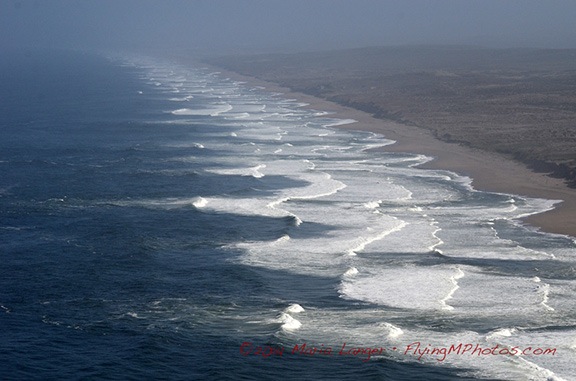





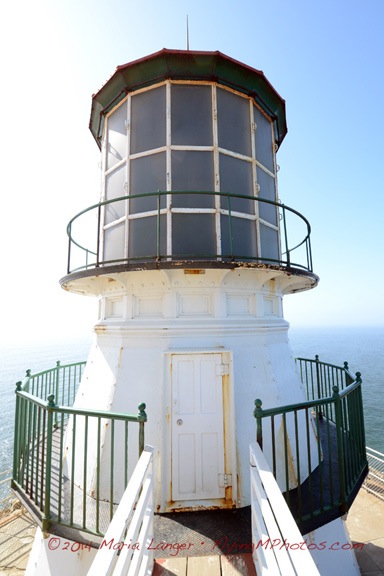


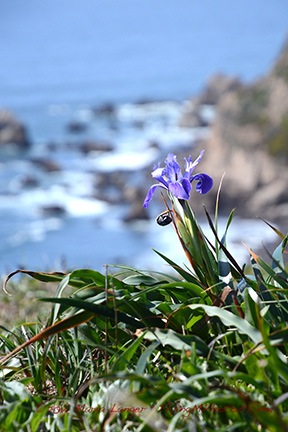

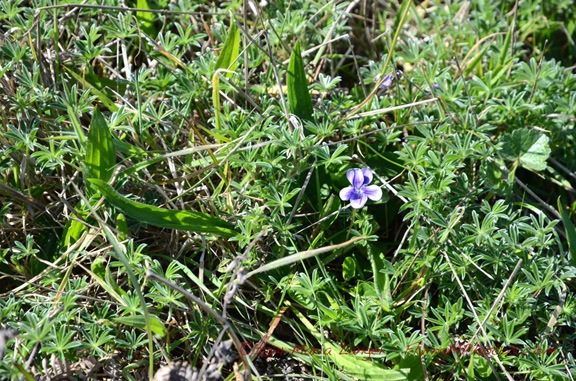
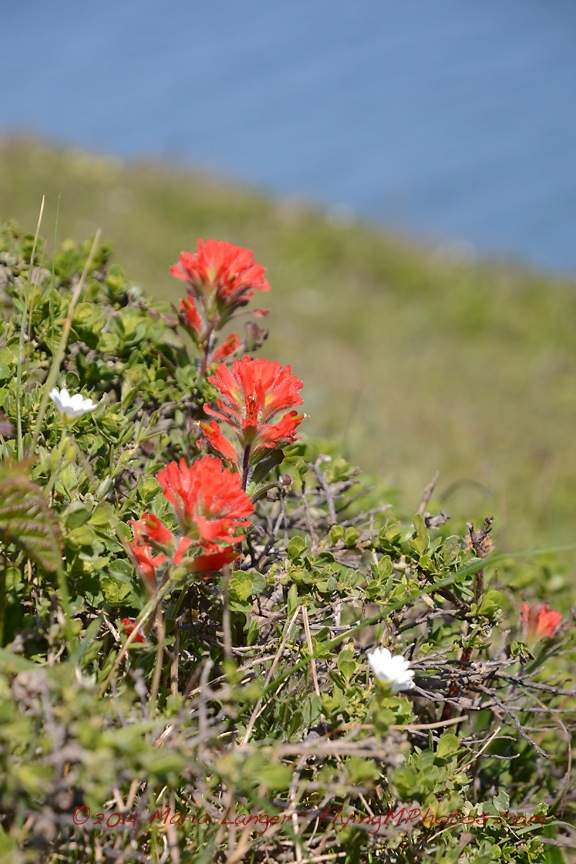
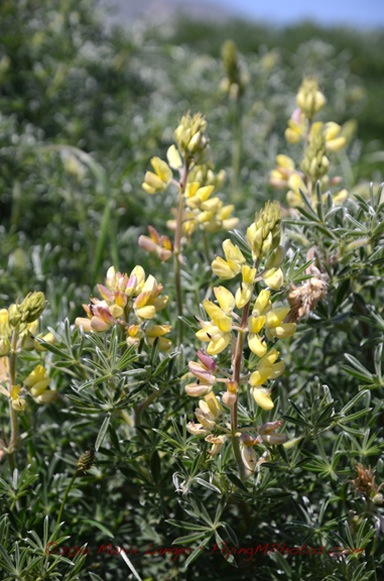
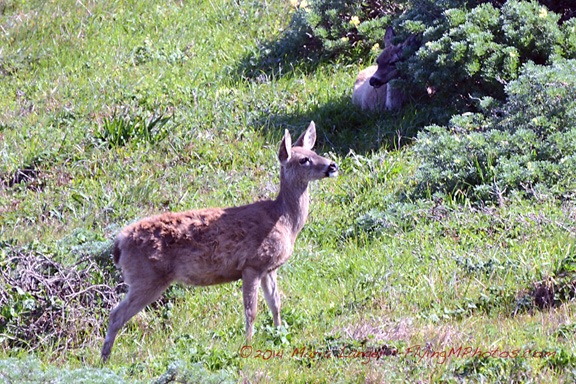
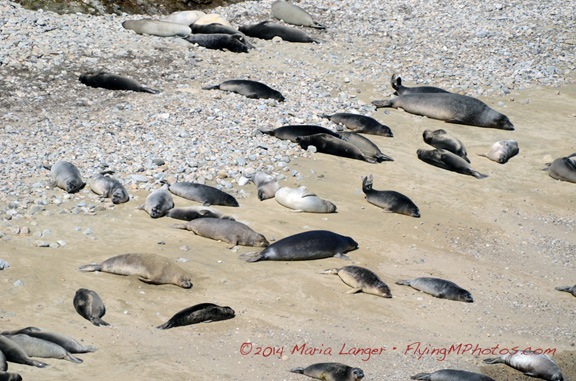
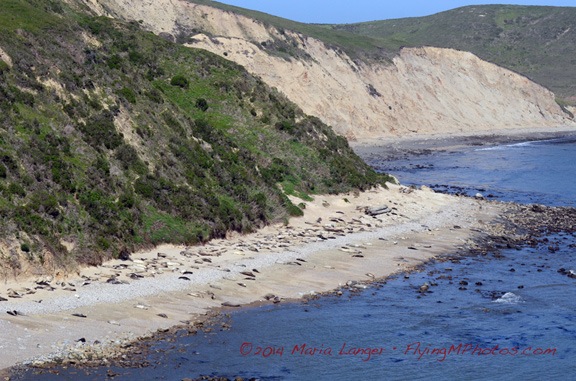
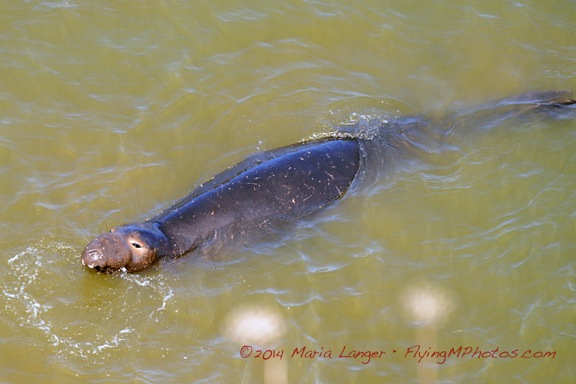
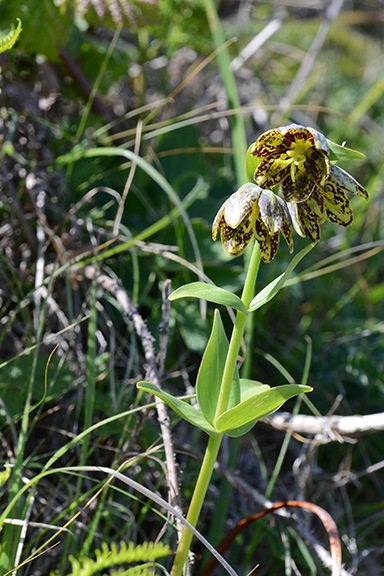
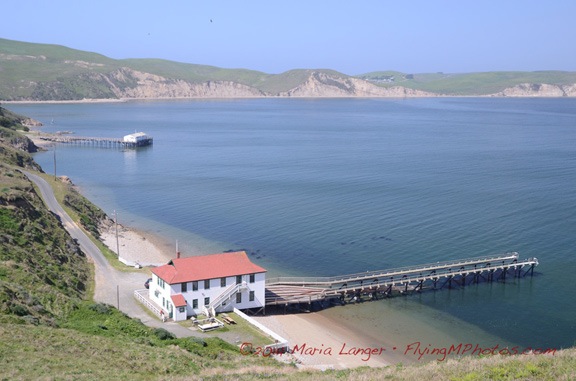

 The road climbed south slowly into the mountains on a narrow strip of park land. We found a parking area right before one of two tunnels and Mike parked the truck. There was a view to the northeast and we could clearly see the Juan De Fuca Strait, which runs between Washington and Canada’s Vancouver Island. It was relatively hazy and the conditions weren’t good for photography.
The road climbed south slowly into the mountains on a narrow strip of park land. We found a parking area right before one of two tunnels and Mike parked the truck. There was a view to the northeast and we could clearly see the Juan De Fuca Strait, which runs between Washington and Canada’s Vancouver Island. It was relatively hazy and the conditions weren’t good for photography.
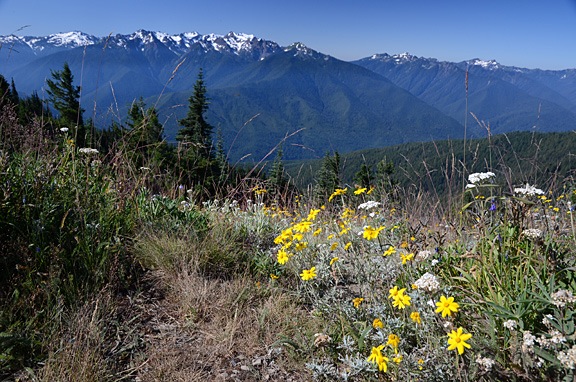
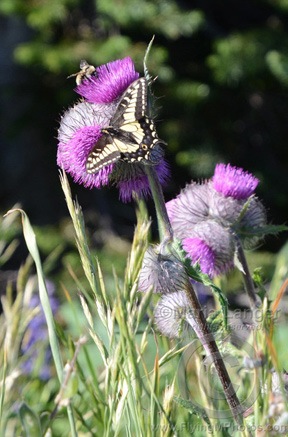

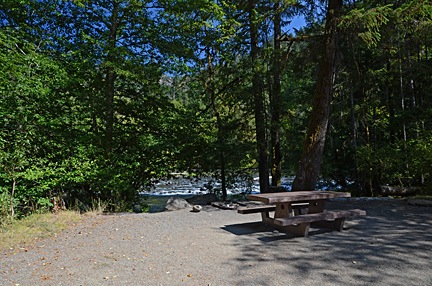 We were hungry and planned to dig into some of the cheese we’d brought along when we got to the observation point near the end of the road. But the road was closed for some kind of construction. So instead, we turned into the Altair Campground, which was mostly empty, and pulled into the first campsite, which was right along the river. We carried the cooler over to the picnic table, opened it up, and had a great meat, cheese, cracker, and cucumber lunch.
We were hungry and planned to dig into some of the cheese we’d brought along when we got to the observation point near the end of the road. But the road was closed for some kind of construction. So instead, we turned into the Altair Campground, which was mostly empty, and pulled into the first campsite, which was right along the river. We carried the cooler over to the picnic table, opened it up, and had a great meat, cheese, cracker, and cucumber lunch. As we got closer and closer to the point, we could clearly hear the ocean waves crashing against rocks. There were a handful of short side trails to points where you could see the rocky shoreline. Some of them had been built up with rustic log rails to prevent a fall into the water below.
As we got closer and closer to the point, we could clearly hear the ocean waves crashing against rocks. There were a handful of short side trails to points where you could see the rocky shoreline. Some of them had been built up with rustic log rails to prevent a fall into the water below.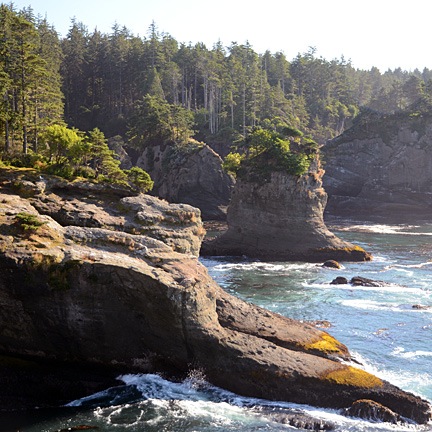 At the end of the trail was a platform that looked out to the northwest. There was an island out there with a lighthouse on it. To the north, was the opening of the strait and Vancouver Island; a container ship slowly made its way in toward the ports. Waves crashed on the shore against odd-looking formations called “stacks.”
At the end of the trail was a platform that looked out to the northwest. There was an island out there with a lighthouse on it. To the north, was the opening of the strait and Vancouver Island; a container ship slowly made its way in toward the ports. Waves crashed on the shore against odd-looking formations called “stacks.”
 There were National Forest Campgrounds along the side of the river. I passed two before I reached the parking area and campground for Silver Falls. I parked and stripped off my gear, locking it up in my bike’s Givi saddlebags. Looking up, I saw the top of the falls — can you see it in the photo? It didn’t seem that far away.
There were National Forest Campgrounds along the side of the river. I passed two before I reached the parking area and campground for Silver Falls. I parked and stripped off my gear, locking it up in my bike’s Givi saddlebags. Looking up, I saw the top of the falls — can you see it in the photo? It didn’t seem that far away.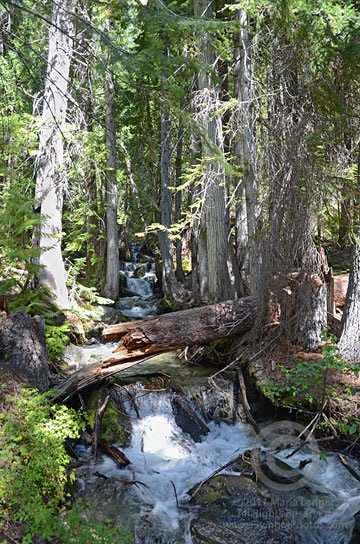 I immediately found myself in a deep, somewhat dark pine forest. As my eyes adjusted to the light, my nose picked up the scent of pine and moisture and my ears heard the sound of rushing water. I came upon the creek immediately — a healthy stream of water gushing over rocks between trees. For me — a desert dweller — it was a real treat.
I immediately found myself in a deep, somewhat dark pine forest. As my eyes adjusted to the light, my nose picked up the scent of pine and moisture and my ears heard the sound of rushing water. I came upon the creek immediately — a healthy stream of water gushing over rocks between trees. For me — a desert dweller — it was a real treat.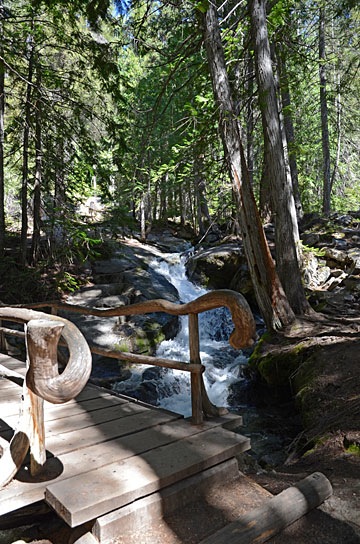 The path was well-maintained, with rustic protective barriers to prevent hikers from accidentally falling into the stream. The bridges were especially rustic looking, sometimes with curved logs making attractive rails. It was surprising to find something so attractively designed on a trail. I began to wonder how much of the trail dated back to the
The path was well-maintained, with rustic protective barriers to prevent hikers from accidentally falling into the stream. The bridges were especially rustic looking, sometimes with curved logs making attractive rails. It was surprising to find something so attractively designed on a trail. I began to wonder how much of the trail dated back to the 
 But I stuck with it and was rewarded with a switchback and another climb. A while later, I was back alongside the stream at yet another streamside bench, photographing some beautiful purple flowers just past the peak of bloom.
But I stuck with it and was rewarded with a switchback and another climb. A while later, I was back alongside the stream at yet another streamside bench, photographing some beautiful purple flowers just past the peak of bloom.
 Then I started down the other side of the creek. At first, it was one long flight of stairs after another. Then the trail moved away from the falls in a series of relatively level paths with switchbacks. In some places, the trail emerged from the forest into the sun; not only could I feel the heat on my skin, but I could smell it. Then back into the trees for cooling shade and pine aromas.
Then I started down the other side of the creek. At first, it was one long flight of stairs after another. Then the trail moved away from the falls in a series of relatively level paths with switchbacks. In some places, the trail emerged from the forest into the sun; not only could I feel the heat on my skin, but I could smell it. Then back into the trees for cooling shade and pine aromas.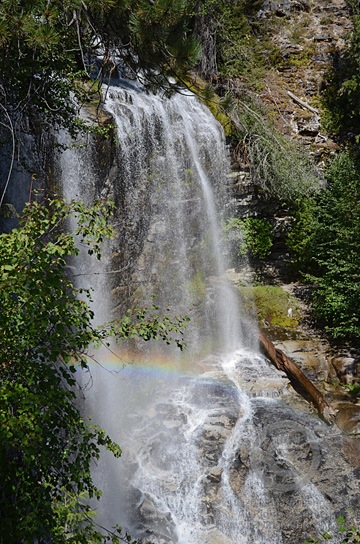 At one point, the trail came back to the falls just below where I’d walked along the ledge on the other side. The mist and sun worked together to produce a small rainbow. I did the best I could to capture the scene with my camera; I really do need to learn how to photograph waterfalls properly.
At one point, the trail came back to the falls just below where I’d walked along the ledge on the other side. The mist and sun worked together to produce a small rainbow. I did the best I could to capture the scene with my camera; I really do need to learn how to photograph waterfalls properly.